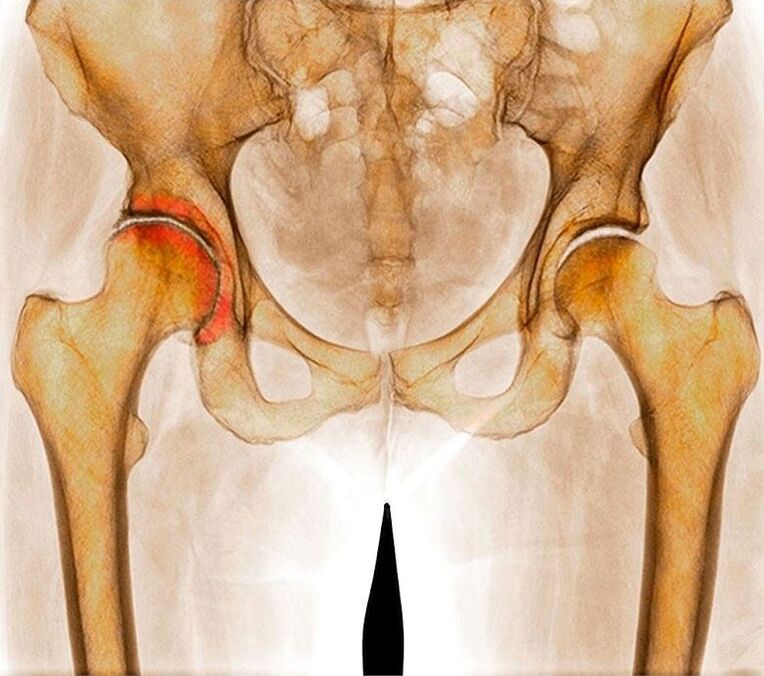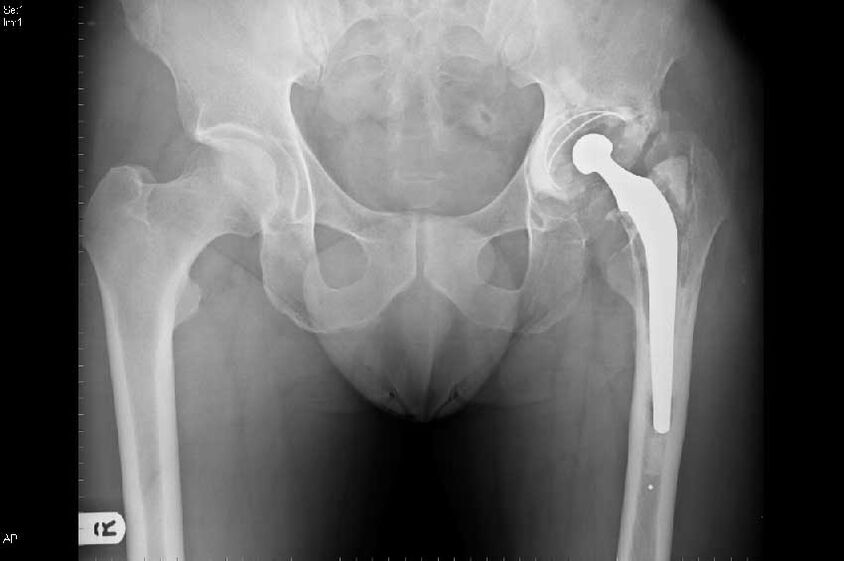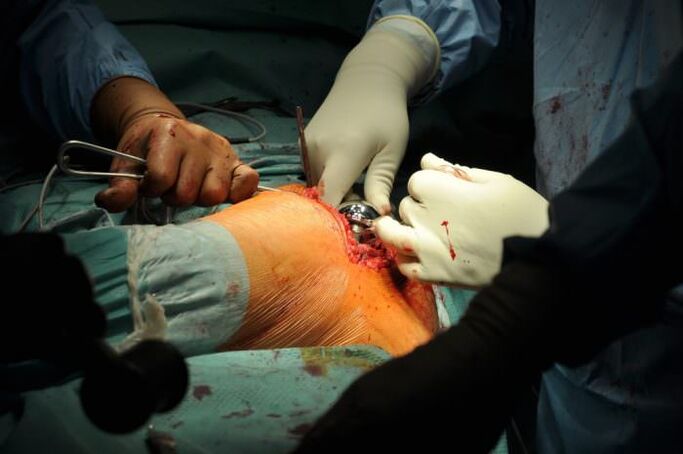What is the arthrosis of the hip joint, what are its symptoms and how to treat it?Arthrosis is a disease that deforms and destroys the joints.Treatment for hip arthrosis is a very long process.In the middle of the last century, coxarthrosis was considered a sentence for the patient, inevitably leading it to an ambulance.But due to the development of medical science, thigh arthrosis can also be stopped in the initial stage of the disease.
What is the arthrosis of the hip joint?
Arthrosis is the disease during which slow destruction and deformity of the joint occurs due to changes in the structure of cartilage tissue.Arthrosis is often confused with arthritis, but these are different diseases, although it may be present at the same time, such as arthrosa arthritis of the hip joint.The difference between arthrosis and arthritis lies in the fact that during arthrosis the deformity occurs not due to infectious tissue inflammation, but due to abnormalities in the metabolic processes.

Combination therapy is used for the causes of the pathology that has helped to determine the right tactics to treat hip arthrosis.When determining how to treat arthrosis of the hip joint, the attending physician can focus on both medicines and physiotherapy.The issue of surgery can also be raised if too serious changes have affected the hip joint - treatment where the drugs are the basis will be ineffective.
Reasons
Coxarthrosis can be triggered by injury or occurs due to old age.Coxarthrosis can also be congenital.However, the main risk factors are as follows:
- Diabetes sugar;
- Hypoteriosis;
- High body weight;
- Poor heredity (genetic predisposition).
These causes can cause coxarthrosis at any age.It is desirable for the risk groups once every six months to undergo a preventive examination by a specialist who deals with joint problems.
Interesting!Many people do not know which doctor treats arthrosis of the hip joint and other joints and unconsciously go to the traumatologist.A doctor who can help in this situation is called an arthrologist.
The arthrologist is a profile specialist who knows not only all tactics and medicines for the treatment of arthrosis, but will also be able to choose the types and analogues of these drugs, according to the individual indicators.
Often arthrosis is diagnosed in patients over 40 years of age.The disease develops in stages, three stages are possible to distinguish:
- There are deviations in metabolism.Disorders of substance synthesis follow.Cutting the cartilage is worse.
- Due to insufficient nutrition, the cartilage becomes less elastic.It is gradually smaller.The purifying clearance is reduced.
- When the cartilage is thinned, the load on the bone tissue increases and bone deformities appear.
With arthrosis of the hip joint, degenerative changes in cartilage tissue can become noticeable to the patient after only years, not immediately in stage 1.
Stages
Each of the stages has its own characteristics.It is important to determine at what stage the arthrosis of the hip joint, the symptoms and treatment at each stage differ in the root.Depending on the stage of the disease, medication or surgery may be prescribed.
Medicines are considered effective only in 1 and 2 stages.Surgery is required in 3 full treatment stages, otherwise the face remains disabled.
In stage 1, they can bring the process back and at the transition 1 to 2 and to 2, stop the process of cartilage destruction and slightly improve the condition of cartilage tissues.Stage 1 is characterized by the following manifestations:
- The pain is manifested only in exercise;
- concentration of joint pain;
- The pain goes away after rest;
- Limb mobility is not limited;
- The condition of the muscle tissue is normal.
With first -degree arthrosis, exclusive radiography and tomography are effective.
The second stage arthrosis is characterized by the following manifestations:
- wandering pain in the thigh area;
- The pain does not go away itself - painkillers are required;
- Motor activity is difficult and limited;
- There is muscle atrophy.
Second -degree arthrosis does not require hardware tests - the disease is diagnosed during visual examination.Nevertheless, they are aimed at MRI and radiography to determine the dimensions of deformation.
In 3 stages, arthrosis has the following manifestations:
- chronic pain;
- Movement is only possible with a cane;
- Inflamed limb with a smaller length.
Signs of hip arthrosis will be implicit and the symptoms characteristic of arthrosis can be completely unexplored.
Characteristic manifestations for arthrosis
The symptoms of arthrosis and its nature depend on the stage of development of pathology.The most pronounced symptom is pain.It may even seem to the patient that he has a fracture of the neck of the thigh, is so intense pain syndrome.The photo shows that the neck of the thigh and hip joint is very close.
Hip arthrosis joint in insidious and in the early stages can only be considered fatigue.For this reason, treatment is slowed down.Sometimes the need to replace the joint with the endoprosthesis, as all medicines are already powerless.The photo shows the elevator's X -ray with the compound replacement options.

Coxarthrosis mainly gives such types of symptoms:
- Pain syndrome.The main source of pain is difficult to determine.If they appear at rest, you should visit the arthologist.
- Some restrictions on movement, light lame.
- After a while, the inflamed limb becomes a little later than healthy.
- There is muscle atrophy - diagnosed during palpation.
Progressive examination methods need to be used, since hip arthrosis does not always give symptoms, it is only possible if there are accurate data.
Coxarthrosis
Upon completion of the arthologist's inspection and the necessary studies are completed, the doctor decides how to treat arthrosis of the hip joint.First, the disease is assigned to ICB code 10. This makes it easier for the doctor to choose the right treatment tactics.
Regardless of the tactics selected, treatment is based on 6 basic principles:
- removal of pain syndrome;
- Recharge and restore cartilage;
- improving the blood flow of the damaged area;
- reduction of joint load;
- strengthening muscle tissue;
- Recovery of joint mobility.
In order to achieve all the goals, it is customary to use combination therapy.For example, the whole positive effect of using chondoprotectors will be destroyed if the load on the inflammatory joint will not reduce the load.Thus, 2-10 approaches are used during the treatment of arthrosis-all depends on the severity of the disease and the general indicators of the patient.The most common approaches can be called the following methods:
- Non -steroidal drugs are combined with exercise therapy and other physiotherapy measures (massages, etc.).
- Chondroprotectors combined with hyaluronic acid.It is more commonly used as a restoration therapy.
- Vasodilator drugs can be combined with both chondroprotectors and non -steroidal medicines and exercises.
- Anesthetic ointments can act in addition to any of the other treatments.They themselves have no positive effect on the joint.
- Corticosteroids such as intraiorticular injections in combination with physiotherapy measures.
To limit the mobility of the joint, hip bands are often used.Physiotherapy and unconventional methods.
Physiotherapy and unconventional methods

In addition to drug therapy, the patient may need to undergo physiotherapy procedures and may even use non -traditional methods as part of treatment.
Interesting!If you follow the principles of a healthy diet and bring your body weight to normal, it is possible to notice the course of the disease and reduce the severity of the symptoms.
The most common additional procedures that patients with arthrosis are as follows:
- Manual therapy lies in the fact that the specialist, using massage techniques, facilitates the course of the disease.
- Exercise therapy (therapeutic gymnastics) - a huge number of different options for physical executions that are excellent in complexity of implementation.Helps to restore atrophied muscles.
- Folk remedies are most doctors against this method, but they can consider it auxiliary therapy.With a competent approach, it increases the effectiveness of drug therapy.
- Homeopathy - Official medicine has not proven the effectiveness of homeopathic therapy, but some patients declare its positive effects and improve the general condition.
- Apitherapy is a very controversial technique based on the treatment of bees and the properties of bee venom.
The following procedures are also applied:
- Magnetotherapy is used as an auxiliary therapy as well as an auxiliary measure.Due to the effects of magnetic fields on the human body, blood flow is improved and metabolic processes are evaluated.
- Hirudotherapy - Due to the components of the components contained in the saliva of leeches, blood flow and blood enter the vessels of atrophied muscles in a larger volume.
- Mud therapy allows you to bring some nutrients through the skin and has a tonic effect.
- The mummy is used both separately and as part of compresses and tinctures.Official medicine does not deny, but does not confirm a positive effect, everything is based on the individual sensitivity of the patient.
- Self -massage is used to increase blood flow and lymphatic flow.Before execution, you should consult an experienced manual therapist or massage therapist.The specialist will teach the right movements and will help to develop his proper performance.
Each additional measure must be agreed with the specialist present.
Shade!Traditional medicine, contrary to many claims, is neutral for additional therapeutic measures.However, with their improper performance (such as acute movements and intense pressure during self -massage), they can worsen the course of the disease.
Some methods related to non -traditional medicine may be contraindicated - an allergic reaction or other negative manifestation is possible after administration.
Surgical treatment

In the short stages of the disease, treatment with the use of the methods of traditional and unconventional medicine does not carry the necessary positive result.The surgery can be a joint replacement or manipulation using a laser.
Replacing your joint allows you to restore all the motor capabilities of the joint.The biggest drawback, with the exception of the high cost of the surgeon's work directly, is not a very significant life.The average joint prosthesis requires replacement every 15 years.
Laser therapy for already operated coxarthrosis is used when the joint part of the bone is rejected.Thanks to this method, it is possible to remove the damaged area and replace it with an insert of artificial materials.
Any surgery for coxarthrosis is a purely temporary measure.However, if it is not performed, then with arthrosis in 3 stages, people inevitably become disabled without the possibility of normal movement themselves.
Prevention
Preventive measures for hip arthrosis are based on the elimination of risk factors that can cause coxarthrosis.The prevention of coxarthrosis is to follow a healthy lifestyle and compliance with common strengthening measures:
- Accept and love an active lifestyle.The biggest danger during the pathology is the lack of any mobility of the joints - salts are deposited and other complications arise.Lightweight but systematic angles are necessary.
- Follow your own diet.You need to stick to such a power style so that there are no weight problems.Nevertheless, you need to refrain from using a large amount of mass in dishes.It is also applied to spicy and spicy dishes.The food should be complete and contain all the necessary micro and macro elements.
- Do not neglect the planned medical examinations - this will reveal the disease at a very early stage.
- To prevent hypothermia, such a negative effect can cause inflammatory processes in the joints and lead to arthrosis.
If you suspect coxarthrosis, you should not try to diagnose yourself.Even an experienced doctor may not always at first glance, and only after examining the patient accurately and confidently to say that it is exactly coxarthrosis.Moreover, the independent prescription of therapy is unacceptable - at least medicine, at least any other.Insufficient awareness of the effect on the body and possible side effects can lead to sad consequences.





































